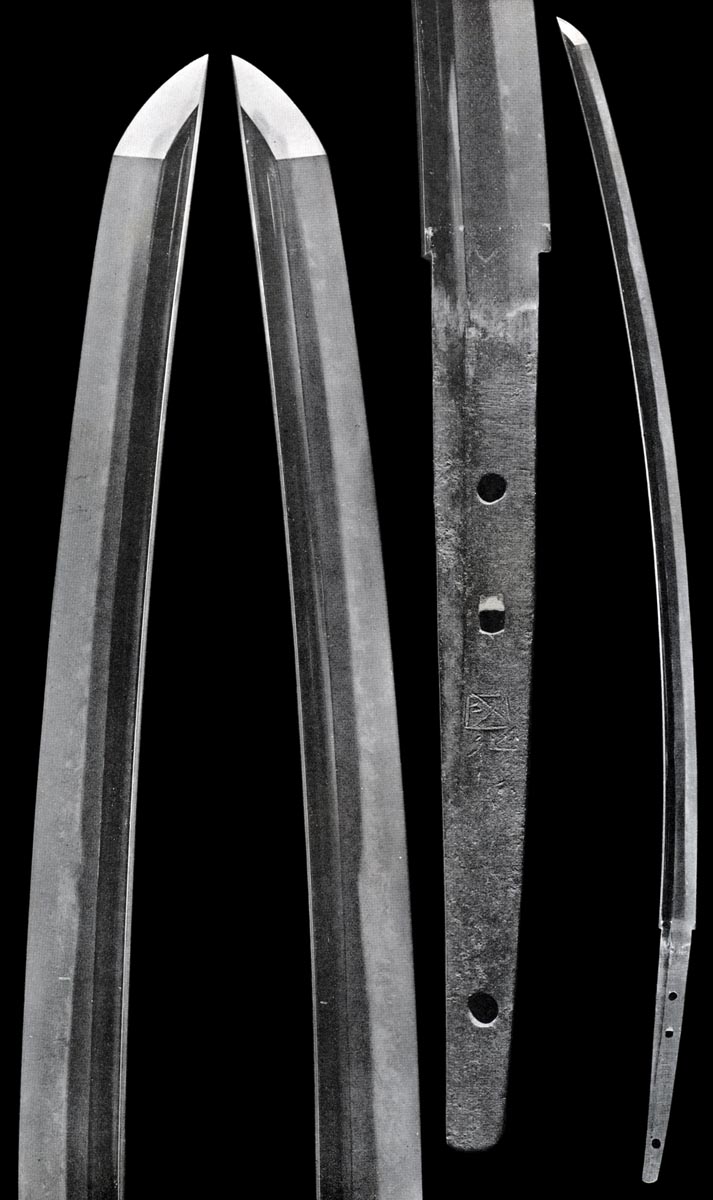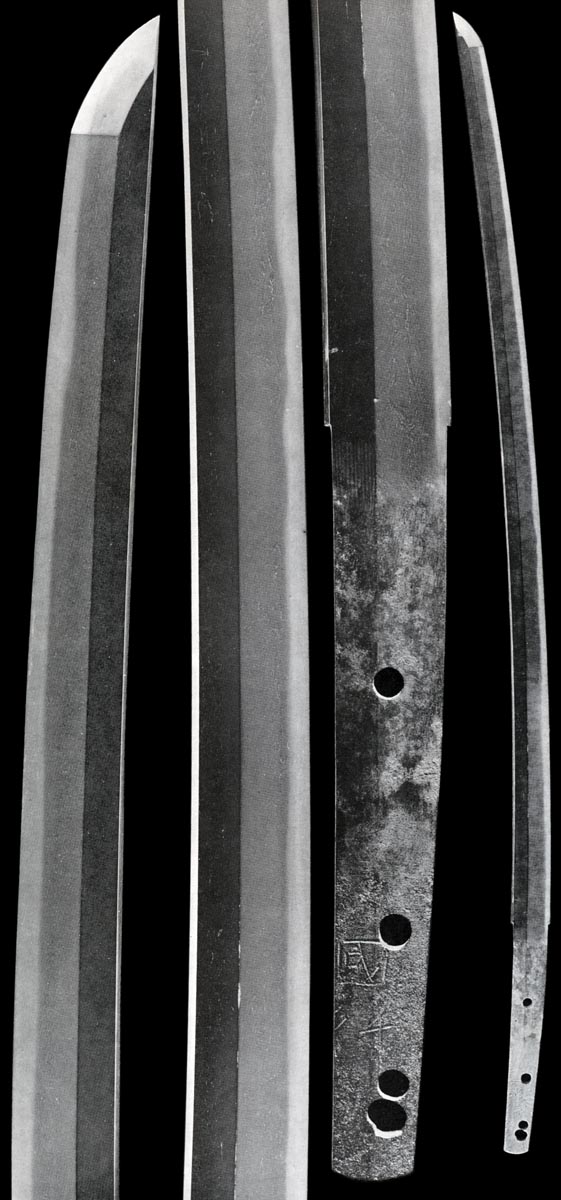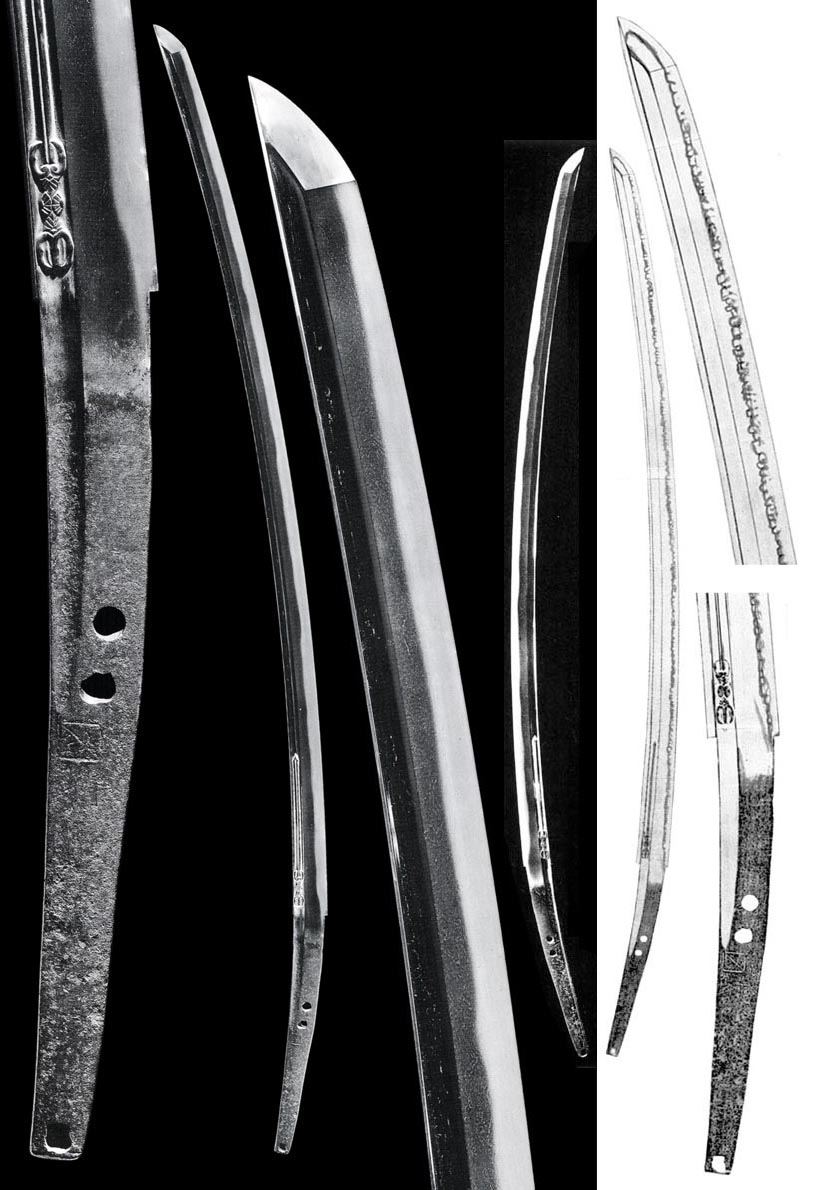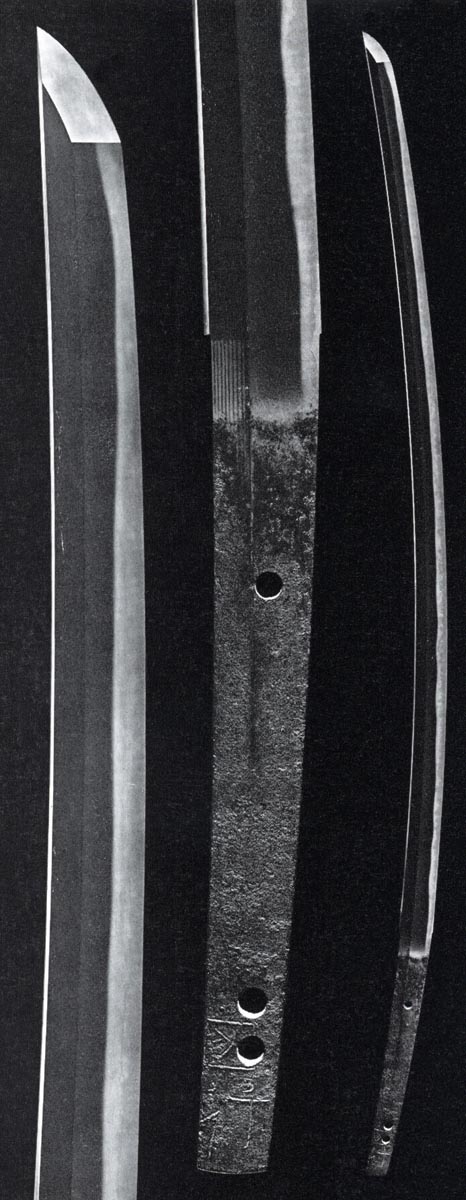| © Copyright Robert Cole 2015
- No copying or distributing YAMASHIRO YAMASHIRO RAI |

|
 |
| RAI can be quiet.
KYOTO was the capitol, the seat of the Emperor, where YAMASHIRO tradition teaches refinement. Both early schools, YAMATO and YAMASHIRO, have an austerity and refinement of style to support. Competing forces drive the time, however, because we have the HOJO in KAMAKURA, where AWATAGUCHI Sixth Son, KUNITSUNA, finds BIZEN SUKEZANE and SABURO KUNIMUNE, laying foundations for an emerging SOSHU. Soon, RAI KUNITSUGU returns from SOSHU with fashion
conscious trends. MITSUTADA's undulating GUNOME wins
over the fading ICHIMONJI KAWAZU CHOJI patterns and is
all the rage, a fashion being spread from SAGAMI like
wild fire: RAI captain, NIJI Two-characters KUNITOSHI had always been in touch and in love with the rocky boulders of Mid-KAMAKURA GUNOME HA, but his departure leaves SANJI, Three Characters RAI KUNITOSHI, to provide the serene and refined austerity of balanced quiet for the RAI school and its product. |
KUNITSUGU's return from KAMAKURA brought the reputation of TOBI-like forms for RAI School, but the origins are earlier. If used, early RAI or AWATAGUCHI may have TOBI-like YAKIBA figures incorporated within the HAMON, as perhaps disjointed CHOJI. TOBI-like formations brings one to pursue MIDARE specialists such as KUNITSUGU, then also Two-characters KUNITOSHI and KUNIYUKI. Another early type of clustering, devoid of TOBI-like formations and edging the HAMON, resembles UTSURI.
KUNIYOSHI HO-JI (f: NORIKUNI): He and his son, KUNIYUKI found RAI School. Made TACHI, TANTO and KEN. NASHI-JI MOKUME has AWATAGUCHI JI-NIE. KO-MIDARE BA or GUNOME couches long NIJUBA. See treatment in AWATAGUCHI KUNITOMO - 1st son |
 Kuniyuki |
KUNIYUKI(1) SHO-GEN (f: KUNIYOSHI): RAI TARO. At MUKAI MYO-JIN in NISHIOKA. He placed his career in the teachings of his father, RAI originator, KUNIYOSHI to become the first true RAI master. As there are no dated examples, the school history has been pieced together from study. There has been heated controversy on the origins of RAI. Historically based conviction proposes RAI, "Coming" tells of a style import from KOREAN roots through MUTSU. See HIROMURA in YAMATO SHIKKAKE School. Other argument extrapolates from a dated death, KUNITOSHI's birth to NIN-JI 1240. This allows that KUNIYUKI son a reliable work period of KO-AN 1278, and thereby re-affirms that for KUNIYUKI as SHO-GEN 1259. Early pieces have FUNBARI but seem evenly narrow to the eye, much like early KAMAKURA SUGATA. His mid-KAMAKURA, wide MI-HABA TACHI has the IKUBI "Boar's Neck" KISSAKI that has forever been described with the most elegant words: All writers are moved to comment of the grace achieved in his work. The HADA is strongly standing with exceptionally bold JI-NIE. HAMON in KO-NIE. Early: KO-MIDARE KO-CHOJI with ASHI. Later: O-MIDARE, O-CHOJI or DAIBO CHOJI-MIDARE with ASHI and YO. His YAKIBA is wide in the later work. BOSHI can be MIDARE but likely a wide SUGU pulls around a CHU-MARU KAERI. There are often BO-HI that extend to the KO-SHINOGI. See KOKUHO KUNIYUKI following
|
|
Kuniyuki - Kokuho Kuniyuki - Kokuho Nagasa: 74.8cm Moto-Haba: 2.9cm Shinogi-Tsukuri, Ihori-Mune, deeply curved, to Ikubi-Kissaki. Bo-Hi both sides. Ko-Itame, tight Nashiji Hada with strong Rai JiNie. Asaki-Notare Hiro-Sugu holds a chaos of spiring Ko-Gunome, Ko-Choji-Midare Ba with Ashi, in Nie, Hotsure and Sungashi and some Inazuma seen. Hiro-Sugu Midare-Komi Boshi with Togari Saki. Ubu, three Mekugi-ana. Signed in the mid. Kuniyuki |
Kuniyuki
- Kokuho Kuniyuki - Kokuho Nagasa: 69.8cm Moto-Haba: 2.9cm Shinogi-Tsukuri, Ihori-Mune, gentle curve, to Chu-Kissaki. Bo-Hi both sides. Strongly standing and running Itame has O-Hada with Rai JiNie and Yubashiri. Asaki-Notare Ko-Nie Deki Hoso-Suguha holds Ko-Gunome, Ko-Choji-Midare Ba with Ashi, Sunagashi and Nijuba. Ko-Maru Hakikake Boshi. Suriage Nakago has four Mekugi-ana. Signed in the Ji. Kuniyuki |
 |
KOKUHO
KUNIYUKI
KOKUHO ~National Treasure~
Width follows the smooth, long reach of this mid-KAMAKURA TACHI SUGATA to support its elongated KISSAKI. A wide BO-HI replaces the SHINOGI-JI. Somewhat early KUNIYUKI work, the YAKIBA style was certainly fuel for the youthful strides of young KUNITOSHI's DAIBO CHOJI patterns. This piece, however, has his father's master work of refinement and complexity. ITAME with profuse JI-NIE. Squarish, fist and T0BI like KO-CHOJI sit like the weathered stacks. KO-ASHI washes through SUNAGASHI while YO dots and anchors. KINSUJI stratifies the line. MONOUCHI clears, with few defined SAKA-ASHI to a smooth SUGU BOSHI that turns in KO-MARU. The whole of the YAKIBA is a gently varying CHU width. A single Vajra SU-KEN HORIMONO rises in the KOSHI-MOTO, BO-HI well. His large signature resides near the MUNE in the midst of a nearly UBU NAKAGO. The altered walls of three MEKUGI-ANA testify to many mountings. |
| Sakakibara
Rai Kuniyuki Sword of Sakakibara Yasumasa |
||
|
|
 |
Kuniyuki Sugata
|
|
|